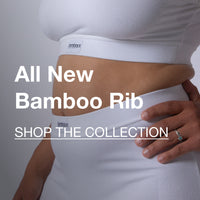Cotton: Types, Uses, Pros, Cons, and More

Browse through your wardrobe –– you’re likely to find quite a few items made from cotton. Cotton is one of the most commonly used fabrics in the world, and for a good reason. At TomboyX, we love cotton for its many wonderful qualities. From a flattering drape to a gorgeously soft feel, there’s a lot to like.
If you want to know a bit more about cotton, put on your reading glasses –– we’re about to go over everything you need to know about this fabric.
What Is Cotton?
Cotton is a natural textile fiber that grows on cotton plants from the genus Gossypium and is made almost entirely of cellulose. Known to be soft and fluffy, cotton is used in textiles all over the world –– more than any other fabric.
Cotton has a wide variety of uses; while we most associate it with clothing textiles, cotton is also used to make canvas, bed sheets, towels, different home decor, and even dollar bills!
What Types of Cotton Fabrics Are There?
There are many different types of cotton fabric. While you could fill a whole book with examples and what sets them apart in terms of look, feel, and make-up, here are some prominent examples of the many types of cotton fabric.
Cotton Jersey Fabric
You can find cotton jersey fabric in all kinds of T-shirts or lightweight summer dresses. Cotton jersey fabric is soft and stretchy; it includes some spandex, which gives it an extra dose of flexibility. This low-maintenance fabric is a favorite for the summertime.
Chambray
Chambray can be compared to a smoother, thinner version of denim. It’s often found in light blue, which further makes it a suitable alternative to denim. Chambray fabric is woven with white yarn in the weft and colored yarn in the warp.
Seersucker Fabric
Seersucker fabric is also known as railroad stripe fabric. It has a slightly puckered or crinkled look on its surface, which makes it less likely to wrinkle than other types of cloth.
Like many other types of cotton, it is well-suited to warm weather –– especially because its texture prevents it from clinging to the skin. Seersucker fabric originates in India.
Cotton Drill
Cotton drill fabric is heavier than some other types of cotton; it is particularly dense and strong. Because of this, it is often used for sturdier clothes, such as work clothes and uniforms.
This durable fabric is woven with a diagonal pattern (also known as twill). You can frequently find it in khakis and work shirts, as well as aprons, cushion covers, and tablecloths.
Brushed Cotton
You are very likely to have worn or at least seen pajamas made of brushed cotton at some point in your life. This warm and insulating fabric is ideal for the fall and winter time.
It’s exceptionally soft and smooth and is often used for quilts and blankets. Brushed cotton is frequently found in plaid or flannel-type patterns.
Cotton Poplin
Cotton poplin features a very tightly closed weave as well as a ribbed texture. It’s a lightweight fabric with a soft and crisp finish.
Cotton poplin is relatively crease-resistant and is therefore popular in dress shirts. From dresses to athletic wear and raincoats, you can find cotton poplin in a vast array of garments.
Cotton Lawn
Cotton lawn is on the finer side of cotton fabrics and is perfect for the summertime. It features a high thread count with a tight weave, which results in a luxuriously smooth and soft fabric surface. Cotton lawn fabric is often somewhat sheer, making it a popular choice for blouses and summer dresses.
Muslin
Muslin cloth is actually also a cotton fabric. This natural product is a plain weave fabric that you frequently find without dye. Sheets are often made of this airy cloth.
Corduroy
Corduroy fabric is made from cotton. It has a velvety feel, with fine ribbed texture throughout. Corduroy is ideal for colder weather (think long pants and jackets) and can also be found on a lot of furniture. It’s not only corduroy that emerges from the cotton bales; blue jeans are also made with cotton.
French Terry Cloth
French terry cloth is a knit fabric. It is usually fully cotton but may also contain other materials such as polyester or Spandex. It consists of soft piles of yarn on one side and loops of yarn on the other. French terry cloth is a plush, medium-weight fabric that is excellent for cozy loungewear.
What Are the Pros of Cotton?
That cotton crop top and socks you love are more than stylish.
Check out their other superpowers:
- Breathable: The fibers that make cotton fabric are naturally hollow. This creates a breezy and breathable fabric, ideal for an active lifestyle and warm weather. The breathability of cotton also makes it the most hygienic choice for underwear.
- Absorbent: Cotton fibers are particularly absorbant. They can hold up to 27 times their own weight in water. This moisture-wicking property makes it popular in active wear.
- Resilient: Cotton stands up well to wear and tear, abrasion, and high temperatures. This makes it resilient and durable, meaning you can hang onto your cotton clothes for a long time.
- Soft: One of the most outstanding qualities of cotton is its softness. Cotton fabrics tend to feel great on the skin, and their softness allows them to be used for everything from clothes to bed sheets.
- Machine Washable: Cotton is a strong and durable fabric. It holds up well to machine washes, which makes it easy to take care of.
- Static-Proof: Some fabrics can get charged up with electricity and lead to tiny electric zaps now and then; cotton, fortunately, does not.
- Comfortable: When you combine breathability, softness, and strength, you come away with a beautifully comfortable garment. When it all comes down to it, that’s what makes cotton so popular.
What Are the Cons of Cotton?
- Wrinkle Prone: Pure cotton fabrics can often wrinkle or crease. As such, cotton is frequently combined with polyester, Spandex, or other synthetic fibers to avoid easy wrinkling.
- Holds Water: While cotton’s moisture-wicking property can be helpful, it also means that it will take longer to dry once wet. If you hang your clothes to dry, you may have to wait a while.
- May Shrink: When combined with too-high heat, cotton can be prone to shrinkage. It’s best to wash and dry it on medium or low heat to be safe.
History of Cotton Production
Cotton has been around for so long that it’s hard to trace it back to its earliest beginnings. We do know that humans have used cotton to spin cloth since at least 3000 BC in the Indus River Valley, as well as the Nile valley in Egypt.
Pieces of cotton cloth from 7000 years ago have also been discovered in Tehuacán Valley in Mexico, as well as Peru. Alexander the Great and his troops wore cotton clothes centuries later.
Cotton cultivation didn’t really exist in Europe until around 800 AD, when Arab merchants brought it over. In the Middle Ages, it was handwoven on a loom. Indian handweavers had a hold over cotton production for a long time.
However, through trade and industrial espionage in the 16th and 17th centuries, the European textile industry began to produce its own cotton. Cotton was used around the world; native peoples of the Bahamas and Cuba were wearing it before any European settlers arrived.
The Industrial Revolution created a further boom in the cotton industry. New inventions, such as the water frame, spinning mule, and the spinning jenny, spurred the sale of cotton. In the US, Eli Whitney’s invention of the cotton gin, as well as the exploitation of slaves, drove cotton production like never before.
Today, cotton is still widely regarded as the most important textile fiber in the world. Brazil, Australia, and Pakistan are some of the largest cotton producers in the world. American cotton growers in the Southwest are famous for Pima Cotton, which many compare to Egyptian cotton.
From Cotton Fields to Red Carpet Runway
The use of cotton is not just huge in the fashion world but in nearly every aspect of contemporary life. This textile fiber has been around since the beginning of recorded history; its hold on humanity can be attributed largely to its versatility as a textile.
From furniture upholstery to your favorite T-shirt, cotton has proved its usefulness time and time again. Soft, comfortable, and reliable, we love cotton.
At TomboyX, we care about sustainability. That’s why our cotton collections are OEKO-Tex Certified so that we can guarantee that from when the cottonseed was planted through the manufacturing process and every part of the supply chain, your clothes are of the highest quality.
Sources:
History of Cotton - Making Cotton into Fabric | History of Clothing
Cotton Fibre - an overview | ScienceDirect Topics
Gossypium - an overview | ScienceDirect Topics
The Domestication History of Cotton (Gossypium) | ThoughtCo






